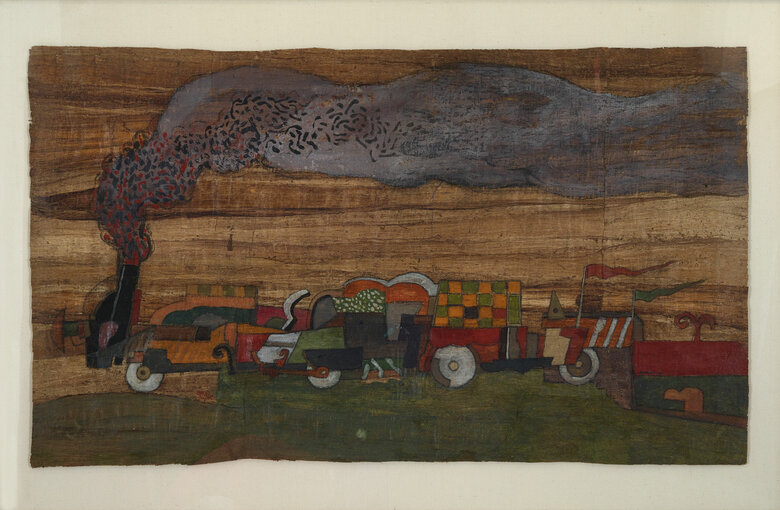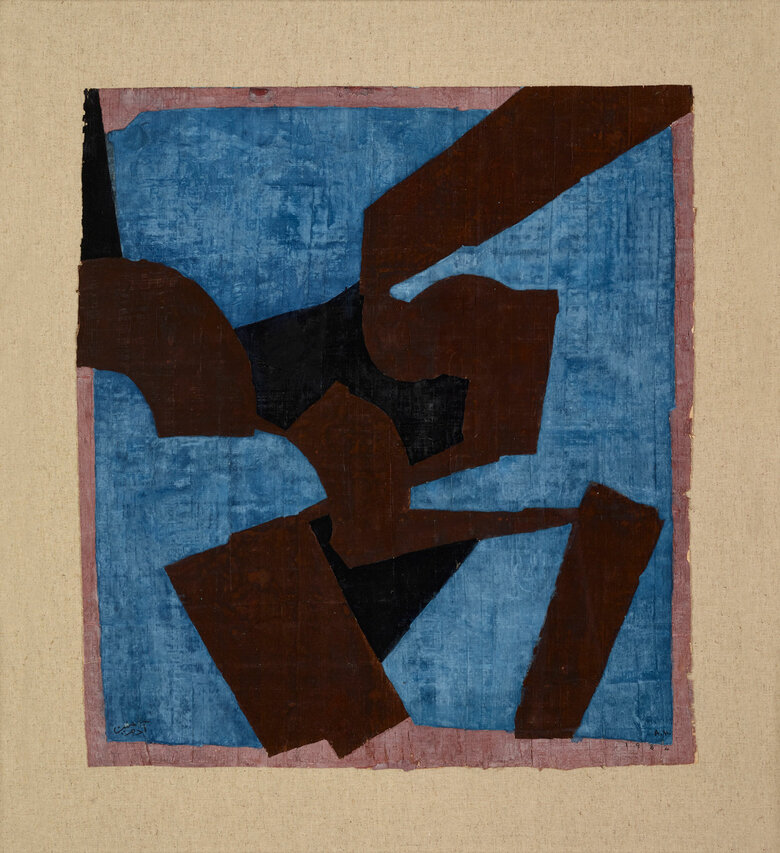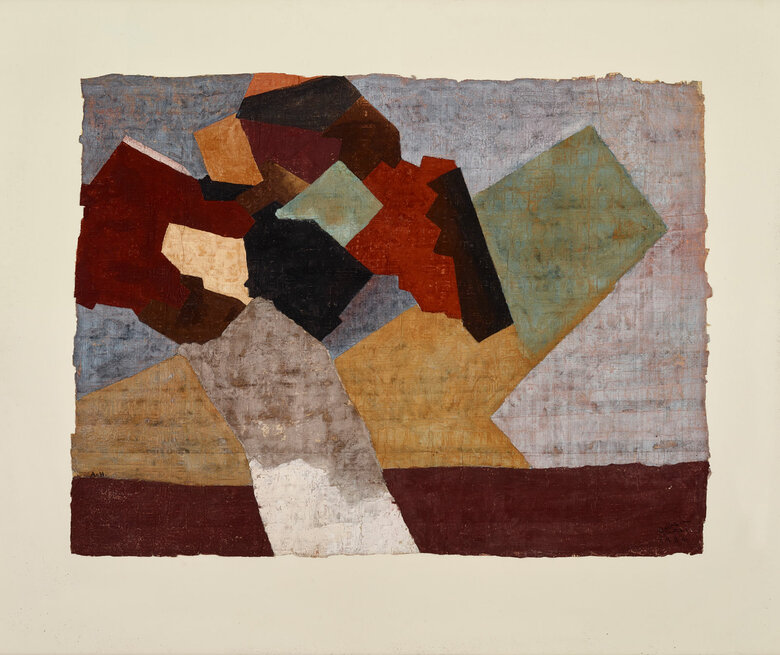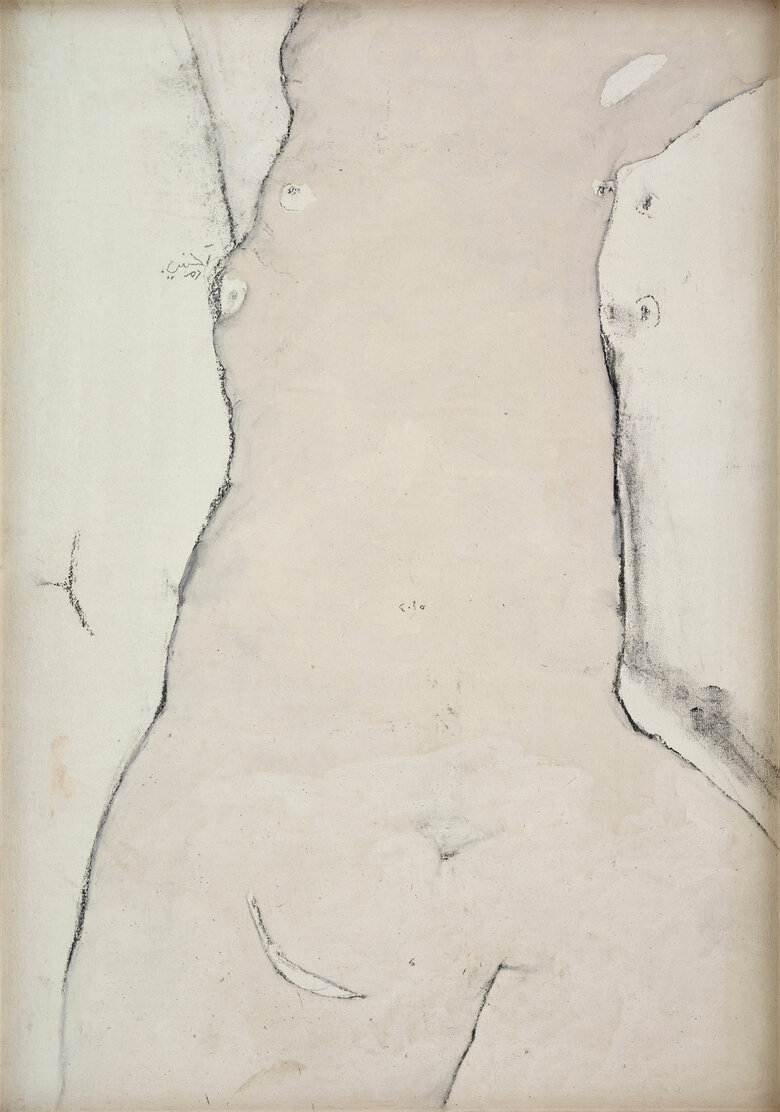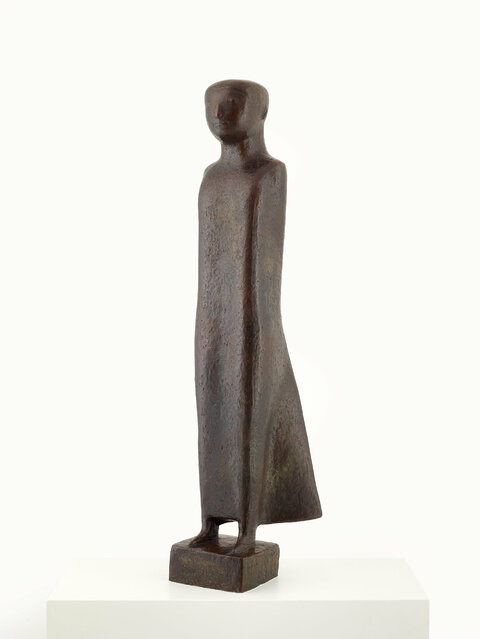Born in the district of Bab el-Shaariya in Cairo in 1929 to a Coptic family from Assiout, Upper Egypt, Adam Henein grew up with respect for traditions and religious tolerance. When he was young,...


ADAM HENEIN, Egypt (1929 - 2020)
Bio
Written by ARTHUR DEBSI
Born in the district of Bab el-Shaariya in Cairo in 1929 to a Coptic family from Assiout, Upper Egypt, Adam Henein grew up with respect for traditions and religious tolerance. When he was young, he received a Muslim education in the kuttab, an elementary Koranic school, and used to go to the Church every Sunday[1]. On the side, he frequented the animated and neighborhood of Haret el-Yahoud, where his father had established his studio, and worked as a silversmith. There, Henein discovered the metalwork, and was trained for the first time by his father, who stimulated his interest in applied arts. At the age of 8 years old, he went to visit with his classmates, the Egyptian Museum in Cairo, which houses the largest collection of Egyptian antiquities in the world. He was totally captivated by the Pharaonic sculptures – especially the statue Sheikh El Balad from 2500 BCE[2], and other artefacts. He would recall later: ‘When I look back on that exceptional moment, I find myself wishing for the return of that event, aspiring to relive that instant when I learned to see. (…) It was exactly that moment that my eyes learned to look’[3]. This experience was such, that he enrolled in the Faculty of Fine Arts at Cairo’s University in 1949, to study sculpture. Graduated in 1953, he then traveled to Upper Egypt, and attended the Atelier of Luxor for several months, from 1954 to 1956. Located in the village of Gourna, this institution was founded by Mohamed Naghi (1888-1956), and provided courses on ancient Egyptian art[4]. Adam Henein consequently familiarized himself with the aesthetics and techniques of this old-age practice. In 1957, he was granted a governmental scholarship, with the help of a teacher, to travel to Germany where he spent a year and a half in Munich, before going back to Egypt.
Adam Henein registered at the Faculty of Fine Arts at Cairo’s University under the name of Samuel Henry, which is his real birth name. In the early 1960s, the artist traveled to Nubia and became aware of the Egyptian cultural authenticity, and history. Changing his name was a way to reconnect to his roots, and his ancestors.[5]
From 1963 to 1966, Adam Henein started his career in the region of Nubia, located between Aswan in southern Egypt and Khartoum in central Sudan, and settled on Elephantine Island. This region is known to be a historical land where the past comes to light, and which highly inspired modern Egyptian artists. There, the artist contemplated the paintings in the tombs in Thebes, and the daily peasant life by the Nile River. From this panorama, he produced with plaster and bronze, numerous sculptures, representing animals, like goats, birds, and owls. He also modelled local people, such as Nesma (1965), which is part of the Dalloul Art Foundation’s collection. This female figure is a seminal example of the artist’s sculpted oeuvre, in which he captured the essence of ancient Egyptian sculpture, combining strength and simplicity. He said: ‘Pharaonic sculpture appears as block, which, though apparently stable and motionless, is animated by an inner movement (…)[6]. Working with bronze, he kept a compact and massive aspect, but he used simplified lines, and abstracted features to shape the body. The character looks elegant, and proud. However, the artist gave dynamism to the work, creating a movement suggested by the dress folded back in the breeze.
The woman figure in Henein’s oeuvre occupied a significant place. The feminist cause accompanied the struggle for the independence of Egypt in the mid-20th century, and Henein saw the woman as a symbol of social injustice[7]. She was responsible for household tasks, and suffered patriarchal oppression. Yet, he didn’t conceal the aesthetic of their bodies like in El Mahroussa (La Protégée) completed in 2015, part of the Dalloul Art Foundation’s collection. Creating a silhouette figure, the curves of the woman embody the shapes of a river, and give the impression of an elongated nude.
By the end of the 1960s, several events shook the stability of Egypt, with the defeat of the Six-Days War in 1967 against Israel, and the death of President Gamal Abdel Nasser (1918-1970)[8]. Adam Henein didn’t feel any enthusiasm to stay, and decided to leave for France with his wife Afaf El-Dib. In 1971, they arrived in Paris to supposedly stay for one year, but he eventually lived there for over twenty-five years. In the French capital city, he imagined another method in his artistic process, and wanted to reconciliate his skills both in painting and sculpting. Through this innovative approach, he worked on an unusual technique, and surprising mediums, seen in the following piece Sycamore (1984), also part of the Dalloul Art Foundation’s collection. Here, he effectively mixed natural pigments with Arabic gum used as a binder, and a pinch of lime[9]. This is an ancestral technique dated from the 3rd millennium BC that Egyptians used to make hieroglyphs. Moreover, Henein chose the papyrus as the support for the composition, and it is reported that the Egyptian artist Tahia Halim (1919-2003) had brought him sheets of papyrus, while visiting him in Paris in 1976[10]. The use of pigments on papyrus offers a peculiar result, because the fibers of the papyrus crack and swell, when they are exposed to the humidity[11]. Thus, the rough and granular appearance of the painting refers to a fresco.
In the 1980s, Adam Henein showed his mastery in the technical use of materials and their respective properties, proving that he somehow followed the footsteps of his artists ancestors. However, he simultaneously demonstrated his ability to give a modern treatment to the characteristics of ancient Egyptian art. Imposing a matured style, he progressively manifested an evident penchant for abstraction. In the work Untitled, executed in 1984, the artist depicted a narrative scene, which resembles an illustration from children’s books. He drew a moving train in two-dimensions, using geometric basic forms like spheres as well as squares, and applying flat colors. On the other side, the cracks of the papyrus give volumes to these shapes, and emphasize the movements of the childlike representation. The child’s spirit and imagination fascinated Henein, who would assimilate it to a form of experience to the world, such as the artists making their own experiences with art[12].
In some other artworks, like Untitled (1984) in the Dalloul Art Foundation’s collection, he moved to a complete abstraction, erasing any kind of figuration, even in his sculpted pieces. In fact, the subject becomes a construction made with areas of colors, and overlapped abstracted shapes. There is also a minimalist trait to his work, which conveys a sort of spirituality, and that transcends the physical reality: Henein considered his paintings and sculptures to be an enchanted moment to live. Again, the use of papyrus is important since the material absorbs the rays of external light without reflecting them like the regular paper[13]. By extension, it is an inner light that enforces the tones of the colors, and harmoniously renders a luminous ensemble. Henein always felt that his sculptor’s profile was more prominent than the one of a painter, and it is no coincidence that his paintings seems to be like ‘sculpted compositions’[14].
In 1989, the former Minister of Culture, Farouk Hosny, appointed Adam Henein as the head of the design team for the restoration of the Sphinx in Gizeh[15]. Going back and forth between France and Egypt, the artist permanently returned to Cairo in 1996. The same year, he founded the International Sculpture Symposium in Aswan, which held an annual workshop and exhibition, and where artists from all around the world would attend. During this time, they could discover and train in the work on granite, directly taken from the quarries. These works were then installed in the Museum of Aswan, of whom Henein was also president. Even if he spent a big part of his time abroad, the artist always remained true to his Egyptian identity, and heritage that he celebrated through his experimental art.
Adam Henein passed away in May 2020, in Cairo.
Notes
[1] Ismail, Fatma. ‘Adam Henein: A Path through Life’ in Khazindar, Mona. Adam Henein. Milan, Italy: Skira, 2005. [P.325]
[2] Adam Henein quoted in Al-Kharrat, Édouard. ‘Adam Henein: A Modern Vision, Deeply Rooted in Ancient Art’ in Khazindar, Mona. Adam Henein. Milan, Italy: Skira, 2005. [P.14]
[3] Adam Henein quoted in Ismail, Fatma. ‘Adam Henein: A Path through Life’ in Khazindar, Mona. Adam Henein. Milan, Italy: Skira, 2005. [P.328]
[4] Radwan, and Nadia. “Between Diana and Isis: Egypt's ‘Renaissance’ and the Neo-Pharaonic Style (1920s‒1930s).” Collections Électroniques De L'INHA. Actes De Colloques Et Livres En Ligne De L'Institut National D'histoire De L'art, INHA, 8 Sept. 2017, https://journals.openedition.org/inha/7194.
[5] Ismail, Fatma. ‘Adam Henein: A Path through Life’ in Khazindar, Mona. Adam Henein. Milan, Italy: Skira, 2005. [P.332]
[6] Adam Henein quoted in Al-Kharrat, Édouard. ‘Adam Henein: A Modern Vision, Deeply Rooted in Ancient Art’ in Khazindar, Mona. Adam Henein. Milan, Italy: Skira, 2005. [P.11]
[7] Ismail, Fatma. ‘Adam Henein: A Path through Life’ in Khazindar, Mona. Adam Henein. Milan, Italy: Skira, 2005. [P.334]
[8] Karnouk Liliane, Modern Egyptian Art, 1920-2003, Cairo, New York, The American University in Cairo Press, 2005. [P.128]
[9] Gibson F., Michael. ‘Adam Henein, a Timeless Art’ in Khazindar, Mona. Adam Henein. Milan, Italy: Skira, 2005. [P.28]
[10] Ismail, Fatma. ‘Adam Henein: A Path through Life’ in Khazindar, Mona. Adam Henein. Milan, Italy: Skira, 2005. [P.338]
[11] Karnouk Liliane, Modern Egyptian Art, 1920-2003, Cairo, New York, The American University in Cairo Press, 2005. [P.129]
[12] Gibson F., Michael. ‘Adam Henein, a Timeless Art’ in Khazindar, Mona. Adam Henein. Milan, Italy: Skira, 2005. [P.30]
[13] Al-Kharrat, Édouard. ‘Adam Henein: A Modern Vision, Deeply Rooted in Ancient Art’ in Khazindar, Mona. Adam Henein. Milan, Italy: Skira, 2005. [P.12]
[14] Al-Kharrat, Édouard. ‘Adam Henein: A Modern Vision, Deeply Rooted in Ancient Art’ in Khazindar, Mona. Adam Henein. Milan, Italy: Skira, 2005. [P.16]
[15] Hosny, Farouk, Henein, Adam. Contemporary Egyptian Artists and Heirs to an Ancient Tradition. New York, USA: Metropolitan Museum of Art, 1999. [Foreword]
Sources
Dorman, Peter F., and Thomas Garnet Henry James. “Sculpture.” Encyclopædia Britannica. Encyclopædia Britannica, inc., January 29, 2019. https://www.britannica.com/art/Egyptian-art/Sculpture.
Eigner, Saeb. Art of the Middle-East, Modern and Contemporary Art of the Arab World and Iran. London, UK: Merell Publishers Limited, 2011.
Hosny, Farouk, Henein, Adam. Contemporary Egyptian Artists and Heirs to an Ancient Tradition. New York, USA: Metropolitan Museum of Art, 1999.
Karnouk Liliane, Modern Egyptian Art, 1920-2003, Cairo, New York, The American University in Cairo Press, 2005.
Khazindar, Mona. Adam Henein. Milan, Italy: Skira, 2005.
Radwan, and Nadia. “Between Diana and Isis: Egypt's ‘Renaissance’ and the Neo-Pharaonic Style (1920s‒1930s).” Collections Électroniques De L'INHA. Actes De Colloques Et Livres En Ligne De L'Institut National D'histoire De L'art, INHA, 8 Sept. 2017, https://journals.openedition.org/inha/7194.
Seggerman, Alexandra, and Fatenn Mostafa Kanafani. “Creating A New World: The Vanguard of Egyptian Modern Art.” Rawi Magazine. Accessed May 20, 2020. https://rawi-magazine.com/articles/vanguard/.
CV
Selected Solo Exhibitions
2024
Khalid Farhan: A Tribute to Adam Henein, CAP Kuwait, Kuwait City, Kuwait
2019
Adam Henein: Lasting Impressions, Sharjah Art Foundation, Sharjah, UAE
Selected Group Exhibitions
2025
Art Week Riyadh 2025, Art Week Riyadh, Riyadh, Saudi Arabia
2024
Arab Presences: Modern Art And Decolonisation: Paris 1908-1988, Musée d'Art Moderne de Paris, Paris, France
2023
In the Heart of Another Country: The Diasporic Imagination Rises, Sharjah Art Foundation, Sharjah, United Arab Emirates
UNTITLED Abstractions, Dalloul Art Foundation (DAF), Beirut, Lebanon
2022
In The Heart Of Another Country, Deichtorhallen Hamburg, Hamburg, Germany
2021
Memory Sews Together Events That Hadn’t Previously Met, Sharjah Art Museum, Sharjah, UAE
Leads & Artistic Cues from the Arab World, Dalloul Art Foundation (DAF), Beirut, Lebanon
2020
Lived Forward: Art And Culture In Doha From 1960-2020, Mathaf, Arab Museum of Modern Art, Doha, Qatar
Masterpieces XIX, Zamalek Art Gallery, Cairo, Egypt
Mokhtar - Henein - Agop, Meem Gallery, Dubai, United Arab Emirates
Art on paper, Elmarsa, Dubai, Al Quoz, Dubai, United Arab Emirates
2019
The Selection, Zamalek Art Gallery, Cairo, Egypt
Abu Dhabi Art 2019, Abu Dhabi, UAE
2018
A Century in Flux, Sharjah Art Museum, Sharjah, UAE
2017
Modern Art from the Middle East, Yale University Art Gallery, New Haven, Connecticut, US
Night was Paper and we were Ink, Barjeel Art Foundation, Sharjah, UAE
2016
The Short Century, Sharjah Museum, Sharjah, UAE
2015
Linked Itineraries, Reminiscences and Representations, Athr Gallery, Jeddah, Saudi Arabia
2014
Paintings, Sculptures & Projects Garden, Mathaf: Arab Museum of Modern Art, Doha, Qatar
Sky Over The East, Emirates Palace, UAE
2013
RE: Orient, Barjeel Art Foundation, Sharjah, UAE
2010
Peripheral Vision, Barjeel Art Foundation, Sharjah, UAE
2000
Metropolitan Museum of Modern Art, New York, US
1999
Metropolitan Museum of Modern Art, New York, US
1991
Institut du Monde Arabe, Paris, France
1988
ASB Gallery, Munich, Germany
1987
Egyptian Cultural Center, Paris, France
1983
Sultan Gallery, Kuwait
1980
Egyptian Academy, Rome, Italy
Awards and Honors
2004
Moubarak Prize, Egypt
1998
Egyptian State Merit Award, Egypt
Publications
2006
Adam Henein, Edouar Al-Kharrat, Michael Gibson, Fatma Ismail
Collections
Adam Henein Museum, Haret al Harani, Egypt
Ramzi & Saeda Dalloul Art Foundation, Beirut, Lebanon
Barjeel Art Foundation, Sharjah, UAE
Sharjah Art Museum, Sharjah, UAE
Mathaf: Arab Museum of Modern Art, Doha, Qatar
Yale University Art Gallery, New Haven, Connecticut, US
The Museum of Egyptian Modern Art, Cairo, Egypt
The Khalid Shoman Collection, Amman, Jordan
Sources
"ADAM HENEIN" ADAM HENEIN Accessed February 23, 2018. http://www.adamheneinmuseum.com/
"Adam Henein." Barjeel Art Foundation. Accessed February 23, 2018. http://www.barjeelartfoundation.org/artist/egypt/adam-henein/.
Khazindar, Mona. Adam Henein. Milano: Skira, 2005.
Radwan, Nadia. "Adam Henein." Mathaf Encyclopedia . Accessed February 26, 2018. http://www.encyclopedia.mathaf.org.qa/en/bios/Pages/Adam-Henein.aspx.
Zamalek Art Gallery, Artist Adam Henein Biography. Accessed February 23, 2018. http://zamalekartgallery.com/en_ex_artist.php?artistID=3&exhibitionID=9&availiable=.
Press
Adam Henein _ Darat al Funun.pdf
shorook_2014.pdf
Khaled Shouman Foundation - Micheal Gibson.pdf
Ahram Online - Sculptor Adam Henein’s show at Aisha Fahmy Palace is a must see.pdf
Barjeel art foundation.pdf
Bahaa - Art Talks.pdf
ENCHANTING EXPLORATIONS - Deepa Pant.pdf
إيناس محيسن - أبوظبي.pdf
التشكيلى.pdf
حوار عبدالرحمن أبوعوف.pdf
صالح رضا النحت المصري تاريخ من الأسرار والأشخاص.pdf
Inside the stone youssef rakha.pdf
AdamHenein_Adam Henein Museum_Press.pdf
آدم حني1 جمال القصاص .pdf
جريدة الحياة – 2010.pdf
تعرف على تفاصيل جائزة آدم حنين لفن النحت - أخبار مصر - الوطن.pdf
Egyptian Artist Adam Henein.pdf
Remembering Adam Henein_ _All that he ever looked for and channelled, it was Egypt_ - The National.pdf
Herald Tribune 1988.pdf
Abu Dhabi art fair.pdf
Fatma Ismail.pdf
Ahram Online - Don’t miss Zamalek Art gallery’s 19th annual group show.pdf
AdamHenein_Adam Henein Museum_Press.pdf
The Egyptian sculptor who made the Sphinx smile - Reader Mode.pdf
Celebrated Egyptian Sculptor Adam Henein Is Dead at 91 – ARTnews.com.pdf
صحيفة الأخبار_انطفأ اليوم النحات المصري آدم حنين عن 91 عاماً.pdf
Shorok_2010.pdf
AdamHenein_The Adam Henein Museum in conversation and photos_ MadaMasr_Press.pdf
Adam Henein—the Egyptian sculptor who spent a decade restoring the Great Sphinx—has died, aged 91.pdf
ADAM HENEIN Artwork
Related with ADAM HENEIN
Become a Member
Join us in our endless discovery of modern and contemporary Arab art
Become a Member
Get updates from DAF
Follow Artists
Save your favourite Artworks
Share your perspectives on Artworks
Be part of our community
It's Free!
We value your privacy
TermsCookiesPrivacy Policies
Become a Member
Get updates from DAF
Follow Artists
Save your favourite Artworks
Share your perspectives on Artworks
Be part of our community
It's Free!
We value your privacy
TermsCookiesPrivacy Policies
Become a Member
Get updates from DAF
Follow Artists
Save your favourite Artworks
Share your perspectives on Artworks
Be part of our community
It's Free!
We value your privacy
TermsCookiesPrivacy Policies
Welcome to the Dalloul Art Foundation
Thank you for joining our community
If you have entered your email to become a member of the Dalloul Art Foundation, please click the button below to confirm your email and agree to our Terms, Cookie & Privacy policies.
We value your privacy, see how
Become a Member
Get updates from DAF
Follow Artists
Save your favourite Artworks
Share your perspectives on Artworks
Be part of our community
It's Free!
We value your privacy
TermsCookiesPrivacy Policies

